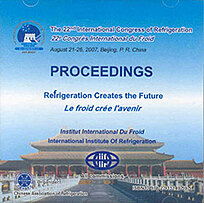
IIR document
An inverse lump parameter method for determination of heat transfer coefficients for an industrial air blast chiller.
Author(s) : MOHAMED I. O.
Summary
An inverse model using lump body was developed to calculate heat transfer coefficients as a dynamic function of time. The model used sequential function specification algorithm to calculate surface heat flux from transient temperature measurements inside a lump body system. Transient temperature measurements were collected during cooling inside an industrial chiller at two different positions with different air velocities using four replicates for each position. The calculated surface heat flux was found two be very accurate as the maximum value of the root mean squares of error for temperature is 0.045°C, lower than the expected error form thermocouple measurements. The calculated heat flux was then used to calculate heat transfer coefficients as a dynamic function of cooling time followed by calculation of time average heat transfer coefficient using numerical integration. The approach developed here could be a pragmatic powerful tool to model special variation of heat transfer coefficients for industrial refrigeration units.
Available documents
Format PDF
Pages: ICR07-C2-1280
Available
Public price
20 €
Member price*
Free
* Best rate depending on membership category (see the detailed benefits of individual and corporate memberships).
Details
- Original title: An inverse lump parameter method for determination of heat transfer coefficients for an industrial air blast chiller.
- Record ID : 2008-0297
- Languages: English
- Source: ICR 2007. Refrigeration Creates the Future. Proceedings of the 22nd IIR International Congress of Refrigeration.
- Publication date: 2007/08/21
Links
See other articles from the proceedings (839)
See the conference proceedings
Indexing
-
HEAT TRANSFER IN FLUIDIZED AND VIBRO-FLUIDIZED ...
- Author(s) : MARHIC L. R., SINGH R. P.
- Date : 1987/08/24
- Languages : English
- Source: Development in refrigeration, refrigeration for development. Proceedings of the XVIIth international Congress of Refrigeration.
- Formats : PDF
View record
-
MEASURED VALUE ACQUISITION AND PROCESSING BY ME...
- Author(s) : KRUG W., WEBER B.
- Date : 1984/09/03
- Languages : English
- Source: Advances in refrigeration and heat pump technology achieved by the application of micro-electronics and the control of systems by micro-electronic devices.
- Formats : PDF
View record
-
Infiltration rate determination for low-tempera...
- Author(s) : REINDL D. T., JEKEL T. B.
- Date : 2008/06/21
- Languages : English
- Source: ASHRAE Transactions. 2008 Annual Meeting, Salt Lake City, UT. Volume 114, part 2 + CD-ROM.
View record
-
HEAT TRANSFER COEFFICIENTS IN THE AIR-BLAST FRE...
- Author(s) : PHAM Q. T., WILLIX J.
- Date : 1987/08/24
- Languages : English
- Source: Development in refrigeration, refrigeration for development. Proceedings of the XVIIth international Congress of Refrigeration.
- Formats : PDF
View record
-
Determination of coil defrosting loads. Parts 1...
- Author(s) : MUTAWA N. K. al-, SHERIF S. A., et al.
- Date : 1998
- Languages : English
- Source: ASHRAE Transactions. 1998 Winter Meeting, San Francisco, CA.
View record
